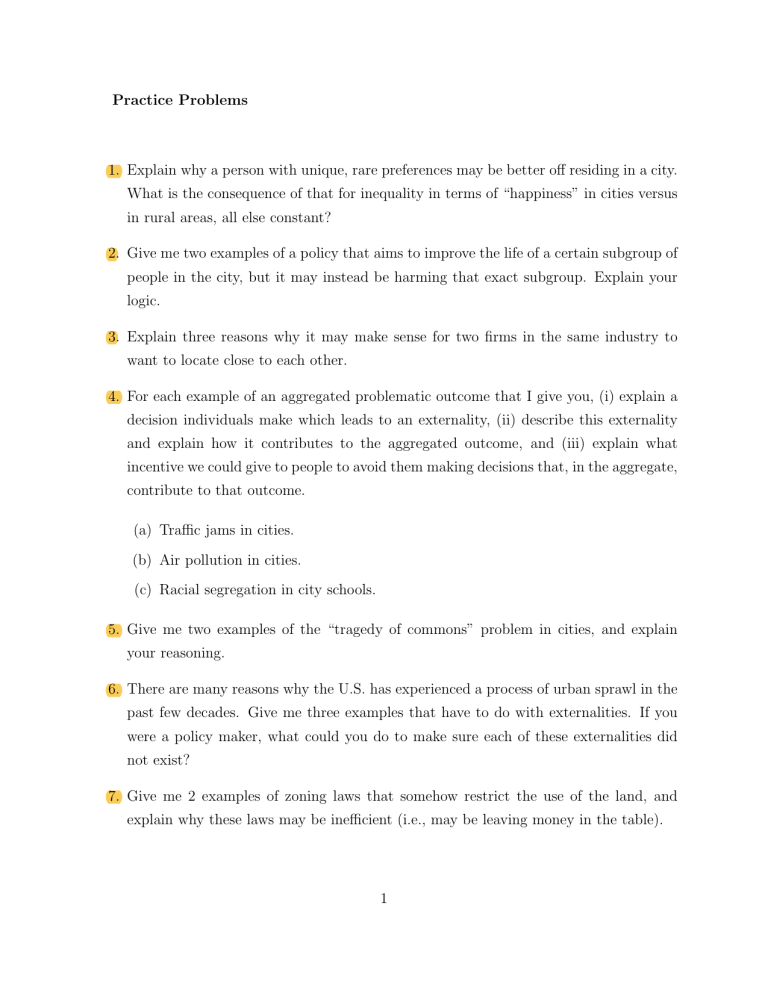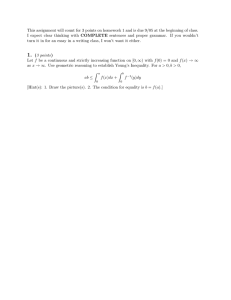
Practice Problems 1. Explain why a person with unique, rare preferences may be better off residing in a city. What is the consequence of that for inequality in terms of “happiness” in cities versus in rural areas, all else constant? 2. Give me two examples of a policy that aims to improve the life of a certain subgroup of people in the city, but it may instead be harming that exact subgroup. Explain your logic. 3. Explain three reasons why it may make sense for two firms in the same industry to want to locate close to each other. 4. For each example of an aggregated problematic outcome that I give you, (i) explain a decision individuals make which leads to an externality, (ii) describe this externality and explain how it contributes to the aggregated outcome, and (iii) explain what incentive we could give to people to avoid them making decisions that, in the aggregate, contribute to that outcome. (a) Traffic jams in cities. (b) Air pollution in cities. (c) Racial segregation in city schools. 5. Give me two examples of the “tragedy of commons” problem in cities, and explain your reasoning. 6. There are many reasons why the U.S. has experienced a process of urban sprawl in the past few decades. Give me three examples that have to do with externalities. If you were a policy maker, what could you do to make sure each of these externalities did not exist? 7. Give me 2 examples of zoning laws that somehow restrict the use of the land, and explain why these laws may be inefficient (i.e., may be leaving money in the table). 1 8. There is a new mall being built in downtown Atlanta. My job is to choose, among the many applicants, which stores will have the right to locate there. After I discuss with world experts in each of the categories, I choose one store for each category. (For example, one Indian restaurant, one burger joint, one men’s clothes store, one men’s shoe store, etc). Can you suggest a better way of allocating stores to the mall than my approach? By “better” I mean in terms of maximizing consumer surplus plus producer surplus. Explain your reasoning. 9. “As schools attempt to improve their quality by paying attention to the preferences of their existing students, segregation increases.” Explain. 10. Imagine a world with no intentional discrimination with respect to gender. Explain why women may be still exposed to a less productive “referral network” for jobs than men do, and what is the consequence of that. 11. Racial discrimination is not equal to racial segregation. Explain. 12. Explain why social movements (e.g., civic rights movements, me too) are more likely to happen in a more diverse society, all else constant. 13. There is a city with 1 million people. The government has 100 million dollars to spare, and it is considering two policies to combat inequality. In policy A, the government spends all available money on what they think poor people need the most. In policy B, the government gives away all money directly to each person (the same amount for each person). Give me an argument for why policy A could be better to combat inequality? Now give me an argument for why policy B could be better to combat inequality? 14. (The New Geography of Jobs) Explain the reasoning for this statement: “Cities that attract highly educated people are more resilient to bad shocks in the economy.” 15. (The Big Sort) Why is it good for society that similar people sort to live around similar people? Why is it bad? 16. (The Death and Life of Great American Cities) Explain why a higher variety of venues in a neighborhood may lead to less crime in that neighborhood? 2 17. (Triumph of the City) Explain the reasoning for this statement: “Restricting buildings to have a maximum allowed height may lead to a less diverse population in the city.” 18. (Happy City) Taking away all traffic signs in a dangerous intersection may reduce accidents. Explain why. 19. (Walkable Cities) Many cities in the U.S. impose restrictions that a establishment must offer 1 car parking slot for free for a given number of square footage. Why is this inefficient (i.e., leaves money in the table)? 3

